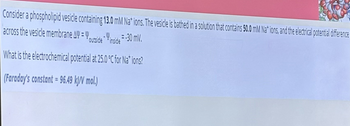
Human Physiology: From Cells to Systems (MindTap Course List)
9th Edition
ISBN: 9781285866932
Author: Lauralee Sherwood
Publisher: Cengage Learning
expand_more
expand_more
format_list_bulleted
Question

Transcribed Image Text:Consider a phospholipid vesicle containing 13.0 mM Nat ions. The vesicle is bathed in a solution that contains 50.0 mM Nations, and the electrical potential difference
across the vesicle membrane AW=
outside inside =-30 mV.
inside-30
What is the electrochemical potential at 25.0 °C for Nations?
(Faraday's constant=96.49 kJ/V mol.)
Expert Solution
This question has been solved!
Explore an expertly crafted, step-by-step solution for a thorough understanding of key concepts.
Step by stepSolved in 2 steps

Knowledge Booster
Similar questions
- Using the Nernst equation, calculate the equilibrium potential for Ca2 and for C1 from the following sets of data: a. Given [ Ca2+ ]0=1mM,[ Ca2+ ]i=100nM, find Eca2+ b. Given [ Cl- ]0=110mM,[ Cl- ]i=100mM, find Eclarrow_forwardOne of the important uses of the Nernst equation is in describing the flow of ions across plasma membranes. Ions move under the influence of two forces: the concentration gradient (given in electrical units by the Nernst equation) and the electrical gradient (given by the membrane voltage). This is summarized by Ohms law: Ix=Gx(VmEx) which describes the movement of ion x across the membrane. I is the current in amperes (A); G is the conductance, a measure of the permeability of x, in Siemens (S), which is I/V;Vm is the membrane voltage; and Ex is the equilibrium potential of ion x. Not only does this equation tell how large the current is, but it also tells what direction the current is flowing. By convention, a negative value of the current represents either a positive ion entering the cell or a negative ion leaving the cell. The opposite is true of a positive value of the current. a. Using the following information, calculate the magnitude of Na [ Na+ ]0=145mM,[ Na+ ]i=15mM,Gna+=1nS,Vm=70mV b. Is Na+ entering or leaving the cell? c. Is Na+ moving with or against the concentration gradient? Is it moving with or against the electrical gradient?arrow_forwardAssume that a membrane permeable to Na+ but not to Cl- separates two solutions. The concentration of sodium chloride on side 1 is higher than on side 2. Which of the following ionic movements would occur? a. Na+ would move until its concentration gradient is dissipated (until the concentration of Na+ on side 2 is the same as the concentration of Na+ on side 1). b. Cl- would move down its concentration gradient from side 1 to side 2. c. A membrane potential, negative on side 1, would develop. d. A membrane potential, positive on side 1, would develop. e. None of the preceding is correct.arrow_forward
- Plasma contains more sodium than chloride. How can this be if individual ions of sodium and chloride exactly balance each other out, and plasma is electrically neutral?arrow_forwardFigure 6.8 Look at each of the processes shown, and decide if it is endergonic or exergonic. In each case, does enthalpy increase or decrease, and does entropy increase or decrease?arrow_forwardDescribe the contribution of each of the following to establishing and maintaining membrane potential: (a) the Na+K+ pump, (b) passive movement of K+ across the membrane, (c) passive movement of Na+ across the membrane, and (d) the large intracellular anions.arrow_forward
- Figure 4.6 Look at each of the processes shown and decide if it is endergonic or exergonic.arrow_forwardThe principal force driving movement in diffusion is______. a. temperature b. particle size c. concentration gradient d. membrane surface areaarrow_forwardConsider a pendulum swinging. Which type(s) of energy is/are associated with the pendulum in the following instances: i. the moment at which it completes one cycle, just before it begins to fall back towards the other end, ii. the moment that it is in the middle between the two ends, and iii. just before it reaches the end of one cycle (just before instant i.). i. potential and kinetic, ii. potential and kinetic, iii. kinetic i. potential, ii. potential and kinetic, iii. potential and kinetic i. potential, ii. kinetic, iii. potential and kinetic i. potential and kinetic, ii. kinetic iii. kineticarrow_forward
arrow_back_ios
arrow_forward_ios
Recommended textbooks for you
 Human Physiology: From Cells to Systems (MindTap ...BiologyISBN:9781285866932Author:Lauralee SherwoodPublisher:Cengage Learning
Human Physiology: From Cells to Systems (MindTap ...BiologyISBN:9781285866932Author:Lauralee SherwoodPublisher:Cengage Learning Principles Of Radiographic Imaging: An Art And A ...Health & NutritionISBN:9781337711067Author:Richard R. Carlton, Arlene M. Adler, Vesna BalacPublisher:Cengage Learning
Principles Of Radiographic Imaging: An Art And A ...Health & NutritionISBN:9781337711067Author:Richard R. Carlton, Arlene M. Adler, Vesna BalacPublisher:Cengage Learning Anatomy & PhysiologyBiologyISBN:9781938168130Author:Kelly A. Young, James A. Wise, Peter DeSaix, Dean H. Kruse, Brandon Poe, Eddie Johnson, Jody E. Johnson, Oksana Korol, J. Gordon Betts, Mark WomblePublisher:OpenStax College
Anatomy & PhysiologyBiologyISBN:9781938168130Author:Kelly A. Young, James A. Wise, Peter DeSaix, Dean H. Kruse, Brandon Poe, Eddie Johnson, Jody E. Johnson, Oksana Korol, J. Gordon Betts, Mark WomblePublisher:OpenStax College

Human Physiology: From Cells to Systems (MindTap ...
Biology
ISBN:9781285866932
Author:Lauralee Sherwood
Publisher:Cengage Learning


Principles Of Radiographic Imaging: An Art And A ...
Health & Nutrition
ISBN:9781337711067
Author:Richard R. Carlton, Arlene M. Adler, Vesna Balac
Publisher:Cengage Learning



Anatomy & Physiology
Biology
ISBN:9781938168130
Author:Kelly A. Young, James A. Wise, Peter DeSaix, Dean H. Kruse, Brandon Poe, Eddie Johnson, Jody E. Johnson, Oksana Korol, J. Gordon Betts, Mark Womble
Publisher:OpenStax College